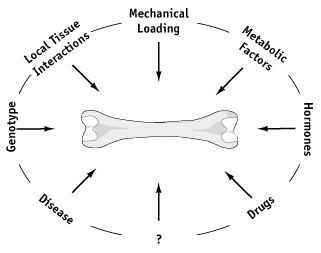1996 Project Reports | Home |
Contents | Previous |
Next |
Long Bone Growth - growth factor mediation
Marjolein C. H. van der Meulen, PhD; Borjana Mikic, MS; William A. Allen,
BS; David M. Kingsley, PhD; Dennis R. Carter, PhD
Bone adaptation is a complex biological process involving the interactions
of numerous local regulators (Fig. 1). Growth factors, particularly the bone
morphogenetic proteins, are intrinsic signalling molecules that play a critical
role during the development and growth of the skeleton. The in vivo roles and
mechanisms of these factors need to be understood. A basic understanding of
their function is necessary to determine if can they be used effectively for
osteoporosis prevention and treatment. However, to elucidate the role of a
single biological factor in a complicated process, evidence must exist that
this factor does indeed influence the process in question. The logical first
step is to use an animal model which has a known deficiency for a particular
molecule and to examine its skeletal processes.
 Figure
1. Genetic and epigenetic influences on skeletal development in growth.
Recently, the short ear mutation in the mouse was discovered to consist of a
complete inactivation of the gene for BMP-5, providing an ideal in vivo model
for testing the function of the BMPs in an animal model. This mutation causes a
wide range of skeletal defects, including reductions of long bone width and the
size of vertebral processes, loss of several small sesamoid bones and a pair of
ribs, impaired fracture healing and an overall decrease in animal size.
Embryological work suggests that the short ear mutation results in a decreased
formation rate of cartilaginous or precartilaginous tissues. However, the exact
role and function of this protein in the skeleton is unknown.
|
First, we characterized the skeletal morphology of short ear mice and normal
littermates at 4 and 26 weeks of age. Our data showed that BMP-5 deletion
results in reduced bone and muscle mass, femoral cross-sectional size and
strength compared to age-matched controls at both ages. The magnitudes of the
differences between short ear and control mice were similar at both time
points, indicating that the long-term growth rates were not significantly
different. These results established that BMP-5 plays a role in early skeletal
development but long-term growth rates are not affected; however, the short
term response was not examined in these experiments.
Based on these earlier studies, we are currently conducting bone adaptation
experiments in the short ear mouse examining the response of the skeleton to
reduced loading. In vivo mechanical loading is known to influence skeletal
development, particularly the diaphyseal structure of the long bones. We are
examining the response of the femora of 35-day old mice to hindlimb suspension
for 2, 4 or 6 weeks. In addition, reloading for 2 and 4 weeks following 4 weeks
of hindlimb suspension is being examined. We are currently completing these
experiments and in the process of analyzing the data. For the data collected to
date, our results clearly show an age effect on all parameters of these growing
animals. There are effects of both the unloading and the short ear gene, but
the exact nature of the differences has not yet been analyzed.
Republished from the 1996 Rehabilitation R&D Center Progress Report. For
current information about this project, contact:
Marjolein C. H. van der Meulen.

